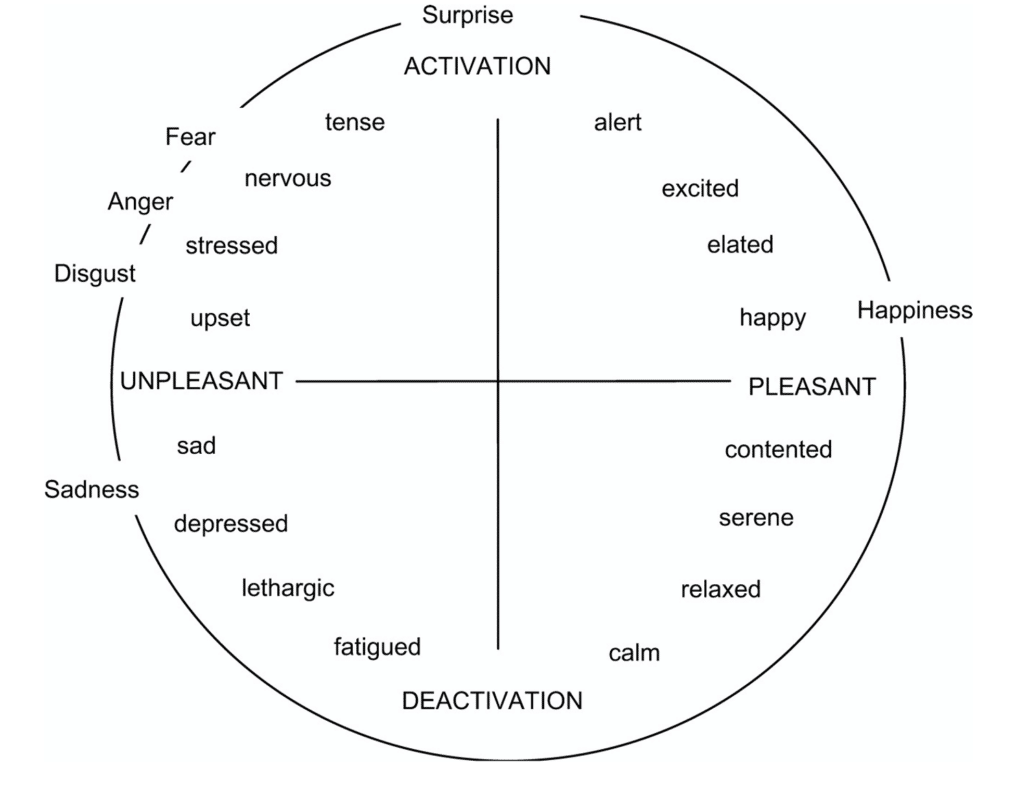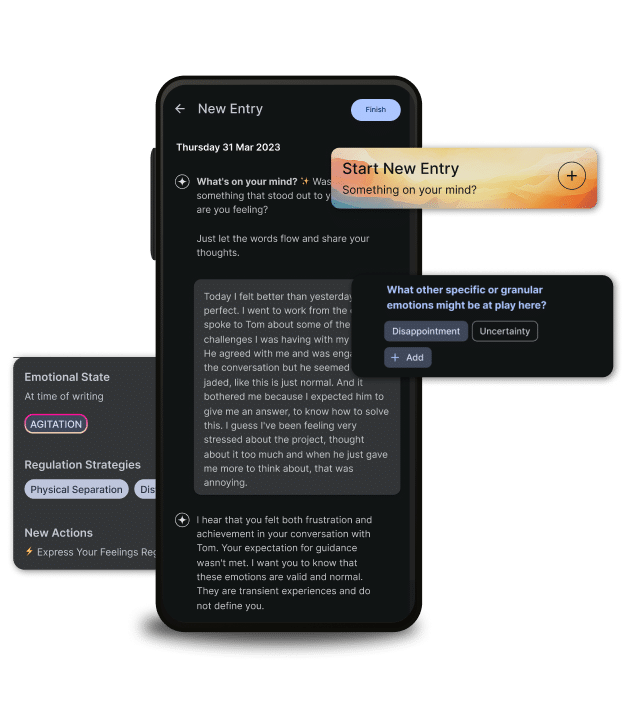Understanding Emotions with InTruth
Pleasant / High Energy
The Top-Right Quadrant

You might feel:
- Interested
- Amused
- Determined
- Joyous
- Light hearted
- Astonished
- Enthusiastic
- Light hearted
- Excited
- Self confident
- Adventurous
In the Nervous System
This quadrant indicates that your nervous system is positively moving toward stimulus and drawing energy for action.
Physiological Changes
Here’s what’s likely happening in the body during this emotional phase:
Increased Heart Rate: The heart rate often increases as part of the body’s preparation for action or engagement. This increase supports the heightened energy levels associated with positive emotions like excitement or joy.
Elevated Blood Pressure: Along with an increased heart rate, blood pressure may also rise temporarily, helping to deliver more oxygen and nutrients to tissues, including muscles, in preparation for physical activity or heightened engagement.
Release of Dopamine and Other Neurotransmitters: Positive high-energy emotions are often accompanied by the release of dopamine, known as the “feel-good” neurotransmitter, which plays a key role in the brain’s reward circuit. Other neurotransmitters, like serotonin and norepinephrine, may also increase, contributing to feelings of happiness and well-being.
Activation of the Sympathetic Nervous System: The pleasant high-energy state triggers the sympathetic nervous system, part of the autonomic nervous system responsible for the body’s “fight or flight” response. While this state is often associated with stress, in the context of positive emotions, it prepares the body for action and excitement rather than fear.
Increased Respiratory Rate: Breathing may become quicker and more shallow as the body prepares for increased activity. This increase supports the elevated heart rate and blood pressure, ensuring that muscles and organs have the oxygen they need to perform.
Muscle Tension and Readiness: Muscles may become slightly tensed and energized, ready for movement. This doesn’t mean the body is stressed; rather, it’s primed for physical engagement or expressive reactions like laughing or dancing.
Enhanced Sensory Perception: Pleasant high-energy emotions can heighten sensory perceptions, making colors seem brighter, sounds more distinct, and smells more acute. This enhanced perception is part of the body’s way of focusing attention on the positive stimulus.
Increased Immune Function: Positive emotions have been linked to a temporary boost in the immune system, making the body more resilient to pathogens. While the mechanism isn’t fully understood, it’s thought that the psychological state can influence physical health in beneficial ways.
Pleasant / Low Energy
The Bottom-Right Quadrant

You might feel:
- At ease
- Pleased
- Hopeful
- Satisfied
- Relaxed
- Calm
- Contemplative
- Peaceful
- Pensive
- Sleepy
In the Nervous System
This quadrant indicates that your nervous system is positively moving toward stimulus and conserving energy.
Physiological Changes
Here’s what’s likely happening in the body during this emotional phase:
Decreased Heart Rate: Unlike in high-energy states, the heart rate tends to slow down, signaling a state of relaxation and calm. This reduced heart rate is part of the body’s parasympathetic response, often referred to as “rest and digest” mode.
Lower Blood Pressure: Blood pressure may decrease to a more relaxed level, reflecting the body’s shift away from the “fight or flight” responses of the sympathetic nervous system to the calming influence of the parasympathetic nervous system.
Release of Serotonin: This emotional state can lead to an increase in serotonin levels, a neurotransmitter associated with feelings of well-being and happiness. Serotonin plays a key role in regulating mood, sleep, and appetite, contributing to a sense of calm and contentment.
Activation of the Parasympathetic Nervous System: The parasympathetic nervous system becomes more dominant, promoting relaxation and restoration. This response helps conserve energy and facilitates processes like digestion and healing.
Deeper, Slower Breathing: Breathing patterns tend to become deeper and more regular, which enhances oxygen intake and promotes a state of relaxation. Deep breathing is also known to stimulate the vagus nerve, further activating the parasympathetic nervous system.
Muscle Relaxation: Muscle tension decreases, leading to a feeling of physical relaxation throughout the body. This relaxation can extend to the facial muscles, often resulting in a content or peaceful expression.
Improved Digestion: With the body in a state of rest, digestive processes can operate more efficiently, as the parasympathetic nervous system supports the body’s ability to absorb and process nutrients.
Enhanced Immune Function: Similar to pleasant high-energy states, positive emotions—even those characterised by low energy—can have a beneficial effect on the immune system, although the mechanisms may vary and the effects can be more subtle.
Unpleasant / Low Energy
The Bottom-Left Quadrant

You might feel:
- Disappointed
- Uncomfortable
- Taken aback
- Apathetic
- Gloomy
- Sad
- Ashamed
- Bored
- Hesitant
- Dejected
In the Nervous System
This quadrant indicates that your nervous system is negatively moving away from stimulus and conserving energy.
Physiological Changes
Here’s what’s likely happening in the body during this emotional phase:
Decreased Heart Rate: Similar to the pleasant low energy state, the heart rate may decrease, but in this context, it’s often a sign of disengagement or lack of interest rather than relaxation.
Reduced Blood Pressure: Blood pressure might drop compared to one’s average level, reflecting a state of lethargy or a lack of motivation.
Lowered Levels of Neurotransmitters: There might be a decrease in the production of neurotransmitters like dopamine and serotonin, which are crucial for feeling pleasure and happiness. Low levels are commonly associated with feelings of sadness or depression.
Activation of the Parasympathetic Nervous System: While this system generally helps promote relaxation and healing, in the context of unpleasant emotions, it might contribute to a feeling of low energy or a lack of motivation to engage in activities.
Shallow or Irregular Breathing: Breathing patterns can become more shallow or irregular, which may contribute to a feeling of fatigue or emotional heaviness.
Increased Muscle Tension in Specific Areas: Unlike the general muscle relaxation seen in pleasant states, unpleasant emotions can lead to tension in specific areas such as the shoulders, neck, or jaw, often as a result of stress or suppressed emotions.
Changes in Appetite: Unpleasant low-energy emotions can lead to significant changes in appetite, either increasing or decreasing, as emotional distress impacts the digestive system and alters eating behaviors.
Disruption of Sleep Patterns: These emotional states can interfere with sleep, leading to difficulties falling asleep, staying asleep, or experiencing restful sleep. The lack of quality sleep can exacerbate feelings of lethargy and low energy.
Decreased Immune Function: Prolonged experiences of negative emotions can have a detrimental effect on the immune system, making the body more susceptible to infections and illnesses.
Reduction in Physical Activity: A common response to unpleasant low-energy emotions is a decrease in physical activity. Individuals may feel too emotionally drained or unmotivated to engage in exercise or other activities they usually enjoy.
Unpleasant / High Energy
The Top-Left Quadrant

You might feel:
- Tense
- Alarmed
- Agitated
- Afraid
- Angry
- Frustrated
- Impatient
- Disgusted
- Distrustful
- Bitter
In the Nervous System
This quadrant indicates that your nervous system is negatively moving away from stimulus and drawing energy for action.
Physiological Changes
Here’s what’s likely happening in the body during this emotional phase:
Increased Heart Rate: The heart pumps faster to supply the body with more oxygen and nutrients, preparing for action. This is part of the fight-or-flight response, aimed at enabling quick responses to stressors.
Elevated Blood Pressure: Alongside an increased heart rate, blood pressure rises to ensure that all parts of the body are well-supplied with blood, enhancing the ability to respond to challenges.
Release of Stress Hormones: The adrenal glands release cortisol, adrenaline, and noradrenaline, hormones that increase alertness and energy levels but, over time, can contribute to wear and tear on the body if levels remain elevated.
Activation of the Sympathetic Nervous System: This part of the autonomic nervous system ramps up the body’s alertness and energy expenditure, preparing for immediate physical activity.
Heightened Respiratory Rate: Breathing becomes faster and shallower to increase oxygen intake, readying the body for rapid action.
Muscle Tension: Muscles, especially in the neck, shoulders, and back, tense up in preparation for physical exertion. This can lead to discomfort and pain if the tension is sustained without release.
Sweating: Increased perspiration helps cool the body down during intense physical activity or stress.
Dilated Pupils: The pupils may dilate to let in more light, theoretically improving vision and readiness to respond to environmental stimuli.
Digestive Suppression: Non-essential functions like digestion can slow down or pause, as the body redirects energy to more critical systems for immediate action.
Heightened Sensory Perception: Sensory sensitivity can increase, making sounds louder or lights brighter, as the body heightens awareness of surroundings for potential threats.
Your Baseline
The Center Circle

You might feel:
- Content
- ‘Normal’
- Even-tempered
- Composed
- Neutral
In the Nervous System
This quadrant indicates that your nervous system is neither moving toward or away from stimulus and is maintaining energy.
Physiological Changes
Here’s what’s likely happening in the body during this emotional phase:
Stable Heart Rate: The heart rate is stable and consistent, indicative of a calm and balanced autonomic nervous system. This stability supports a sense of physical equilibrium.
Normal Blood Pressure: Blood pressure remains at a normal, healthy level, reflecting the body’s state of relaxed alertness without the extremes of stress or relaxation.
Balanced Neurotransmitter Levels: Neurotransmitter levels, including dopamine, serotonin, and cortisol, are balanced, contributing to a mood that is neither too elevated nor too depressed.
Optimal Activation of the Autonomic Nervous System: Both the sympathetic and parasympathetic branches of the autonomic nervous system are functioning in harmony, supporting a state of homeostasis where the body’s physiological systems operate efficiently.
Regular Respiratory Rate: Breathing patterns are regular and even, which helps maintain a sense of calm and can facilitate clear thinking and effective decision-making.
Relaxed Muscle Tension: Muscle tension is minimal, with the body feeling neither too activated for action nor too relaxed. This supports physical comfort and readiness for various activities.
Effective Digestion and Immune Function: With the body not under stress or excessively relaxed, digestion and immune functions operate effectively, supporting overall health and well-being.
Mental Clarity and Focus: The balanced emotional state fosters an environment for clear thinking, focus, and effective problem-solving. Individuals may find it easier to concentrate and engage in tasks without the distraction of strong emotions.
Openness to Experience: Being in the center baseline allows for flexibility in responding to changes in the environment or within oneself. Individuals may be more open to experiencing a range of emotions and activities without being predisposed toward a particular emotional response.
Adaptability: This neutral state supports adaptability, allowing individuals to respond to life’s challenges and opportunities with a balanced approach, making adjustments as needed based on new information or changing circumstances.
Why This Model
We embrace the complexity of emotions through the lens of the Circumplex Model of Affect. Developed by James A. Russell, this model serves as the cornerstone of our emotional tracking, offering a nuanced view that transcends traditional emotional categorisations.
The Circumplex Model plots emotional states along two dimensions: arousal (the level of excitement or activation) and valence (the degree of pleasantness).
By translating heart rate variability (HRV) data through our machine learning model, we map your emotions onto this two-dimensional space, revealing the dynamic nature of how you feel.
Our choice to employ the Circumplex Model is driven by its proven effectiveness in emotion research, particularly studies involving biometric measurements. Its widespread acceptance and use in scientific exploration underscore its reliability and depth in capturing the essence of our emotional states.
This model aligns with our belief that emotions exist on a continuum, challenging the conventional view of emotions as merely “positive” or “negative.” In a culture that often glorifies positive emotions and suppresses the uncomfortable ones, the Circumplex Model empowers us to foster a more balanced and informed engagement with our emotional selves.
By adopting this framework, InTruth aims to shift the narrative around emotions, encouraging a deeper, more constructive interaction with every facet of our emotional lives. It’s a tool not just for understanding but for growth, enabling us to navigate our emotions with confidence and insight.
What's Next for InTruth?
Our journey into understanding emotions takes a deeper dive as we recognise the intricate role the brain plays in shaping our emotional experiences. Inspired by Lisa Feldman-Barrett’s insights in “The Theory of Constructed Emotion,” we acknowledge that our feelings are a complex blend of the sensory present and the remembered past. While heart rate variability offers a window into our emotional state, the true richness of emotion resides in the brain’s unique connections and interpretations.
Moving forward, InTruth is set to harness the power of personalised AI analysis, transcending the one-size-fits-all approach to map out the unique patterns of your emotional landscape. By integrating AI journaling, calendar insights, and activity tracking, we aim to unveil the layered complexity of emotional perception that typically remains locked within the brain.
This innovative approach will empower our users with actionable insights, enabling a profound understanding of their emotions and fostering meaningful change. InTruth is not just about tracking emotions; it’s about unlocking the narrative of your emotional life, tailored just for you.





